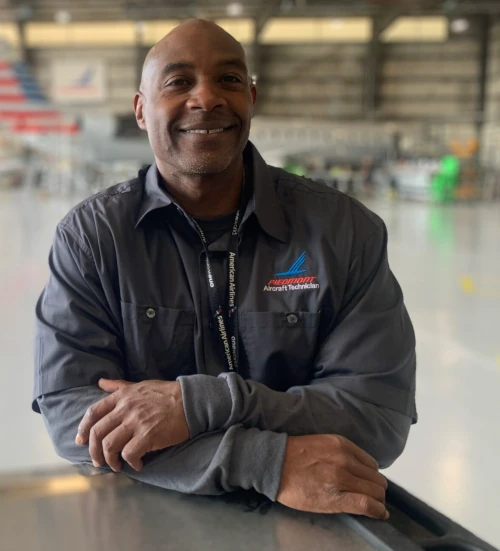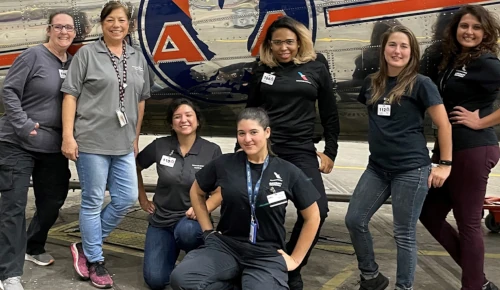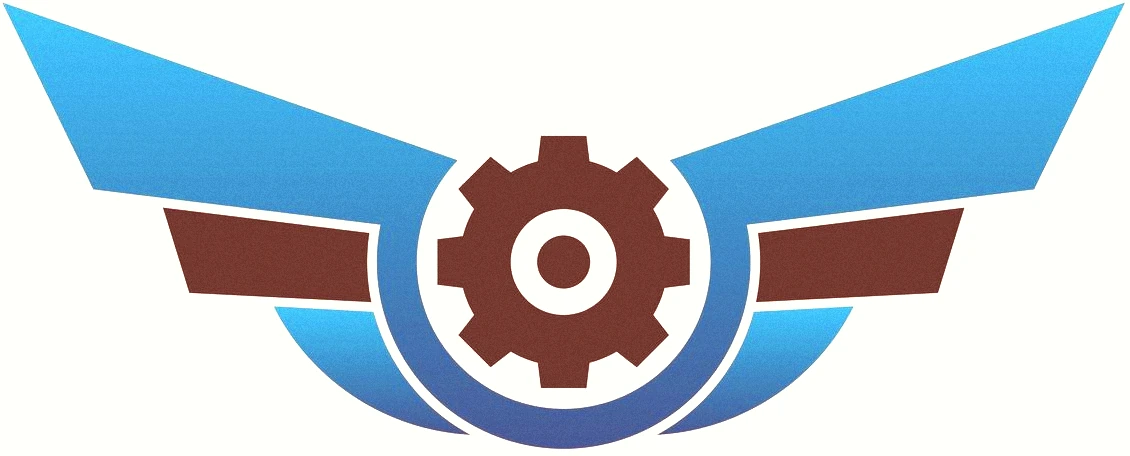From Previous Job to A&P: Real Stories of Career Change Success in Aviation Maintenance
The aviation maintenance industry has become a beacon for career changers seeking stable, well-paying work with clear advancement opportunities. With starting salaries exceeding $50,000 and a critical shortage of qualified technicians, becoming an FAA-licensed Airframe & Powerplant (A&P) mechanic offers both financial security and job satisfaction that many other industries cannot match.
Unlike many career changes that require extensive prerequisites or advanced degrees, aviation maintenance welcomes professionals from diverse backgrounds. The stories of successful career changers prove that with dedication and proper training, anyone can build a rewarding future in aircraft maintenance.
From Printing Press to Flight Line: Dounell Griffin’s Journey at 48

Dounell Griffin’s story exemplifies how career change opportunities can literally come from anywhere. After 15 years as a printing press operator for the Florida Lottery, Dounell heard a radio advertisement while working as a fuel handler at Norfolk International Airport. At age 48, he decided to completely reinvent his career.
“After being selected for the program, I received an education in 12 months with 100% paid tuition and a guaranteed job with Piedmont upon completion of my certification,” Dounell shares. Through Piedmont Airlines’ Tuition Payment Program in partnership with the Aviation Institute of Maintenance, he left his full-time job to attend school 40 hours per week.
Despite being 25 years older than his classmates, Dounell became one of the top students and was selected as class lead. Today, he works as an Avionics Technician at Piedmont’s Salisbury base. “If I can accomplish changing careers at age 48, then anyone can,” he reflects.
From Ramp Agent to Aircraft Technician: Kyle’s Alaska Airlines Success

Kyle H.’s transformation shows how companies are creating pathways for internal career advancement. Starting as a ramp service agent in Juneau at age 20, Kyle worked his way up through various positions before pursuing his A&P license through Alaska Airlines’ Maintenance Technician Development Program.
Juggling work and school was challenging—Kyle often attended classes after graveyard shifts, catching naps in his truck between commitments. But with company support, including up to $12,300 in stipend assistance and mentorship opportunities, he successfully transitioned to a line aircraft technician role in Anchorage.
“Hard work and determination will always pay off, and I’m living proof,” Kyle emphasizes, encouraging others considering similar career moves.
Breaking Barriers: Women Leading Change in Aviation Maintenance

The aviation maintenance field is also seeing increased diversity, as highlighted by American Airlines’ first all-female maintenance team. Team member Pari Soneji’s journey illustrates how technical backgrounds can translate into aviation maintenance success. Working as an aeronautical engineer in India, she transitioned to hands-on aircraft maintenance after moving to the United States and attending Vaughn College of Aeronautics and Technology.
“I’m happy being an AMT because I actually get to be around the aircraft I studied and learn about the systems more hands-on,” Pari explains. Her experience demonstrates how even highly educated professionals find fulfillment in the practical, technical work of aircraft maintenance.
The Wide Range of Career Change Success Stories
We did an analysis of a Reddit thread called “Those who became AMT’s later in life, how old were you & what did you do before?“
It revealed the remarkable diversity of backgrounds that successfully transition into A&P careers:
Key Insights:
- Age Range: Career changers ranged from 21 to 65 years old when starting A&P school
- Common Theme: Most respondents expressed satisfaction with their career change
- A&P School Difficulty: Mixed responses – some called it “adult daycare,” others said it requires effort but is manageable
- Financial Improvement: Many reported significant salary increases, with some reaching six figures
Career Change Examples by Previous Profession:
Construction & Manual Labor
- Property manager/handyman → AMT at age 55
- Construction manager (7 years) → airline tech
- Heavy equipment mechanic → industrial → GA aviation at age 28
- Steel mill worker → truck driver → AMT at age 39
Healthcare
- Registered nurse → AMT at age 42 (citing burnout and workplace issues)
- Hospital worker → AMT at age 30
Food Service & Hospitality
- Hair stylist (8 years) → AMT at age 27
- Dining room manager at country club → AMT at age 40
- Restaurant chef → AMT at age 24
- Deli counter worker → AMT at age 17
- Server (making $35-40/hour) → AMT at age 35
Technology & Office Work
- IT student → AMT at age 21
- Software architect/principal SRE → AMT at age 50
- Computer science dropout → AMT at age 22
- Software development/technology startups → AMT at age 65
- IT/telecommunications company owner → planning A&P school at age 50
Transportation
- Truck driver (10 years) → AMT at age 39
- Airline operations/dispatch → AMT at age 33
Military & Security
- Navy hydraulics mechanic → teaching AMT at age 51
- Marine Corps (12 years) + contractor work → AMT at age 35
- Infantry (9 years) → AMT, then engine tester
- Police officer → AMT
- Air Force (20 years) → Lockheed → AMT at age 46
Retail & Customer Service
- Warehouse work → AMT at age 31
- Home Depot, warehouse manager, call center → considering AMT at age 35
- Various retail jobs → AMT at age 30
- Gate/counter agent → apprentice program at age 25
Other Professions
- Geologist (oil field) → AMT at age 39
- Law firm employee → AMT at age 32
- Commercial fishing, automotive work → AMT at age 35
- Engineering student (dropout) → AMT at age 22
Notable Quote: One respondent emphasized that many reached six-figure salaries and called it “the best move I ever made.”
Why Aviation Maintenance Appeals to Career Changers
Financial Incentives and Job Security
Starting salaries for A&P mechanics typically exceed $50,000, with experienced professionals at major airlines often earning six-figure incomes. The critical shortage of qualified technicians—the industry needs approximately 47,000 new technicians by 2027—ensures strong job security and advancement opportunities.
Clear Training Pathways
Unlike many technical fields, aviation maintenance offers structured, standardized training programs. FAA Part 147 schools provide comprehensive 12-24 month programs that prepare students for immediate employment. Many programs, like those at International AeroTech Academy, offer evening classes designed for working adults.
Transferable Skills Advantage
Career changers often discover their previous experience provides unexpected advantages:
- Customer service skills prove valuable when working with pilots and airline personnel
- Attention to detail from retail, healthcare, or administrative work translates perfectly to aircraft inspections
- Problem-solving abilities from any field enhance troubleshooting capabilities
- Leadership experience helps with team coordination and safety management
Hands-On Satisfaction
Many career changers cite the satisfaction of working with their hands and seeing tangible results. Unlike desk jobs where accomplishments can feel abstract, aircraft maintenance provides immediate, measurable outcomes that directly impact safety and operations.
Overcoming Common Career Change Concerns
“Am I Too Old to Start Over?”
Success stories span ages from early 20s to mid-60s. Dounell Griffin’s achievement at 48 and one Redditors start at 65 prove that motivation and dedication matter more than age. Many employers value the maturity, work ethic, and life experience that older students bring.
“Can I Afford the Transition?”
Innovative financing options make career changes more accessible:
- Employer partnerships like Amazon’s Career Choice program and Alaska Airlines’ development program
- 100% tuition financing options available through specialized lenders
- Military benefits including GI Bill and VR&E programs for veterans
- Evening and weekend programs allowing students to maintain income while training
“Will My Background Be Valued?”
Aviation maintenance requires diverse skills beyond mechanical ability. Communication, teamwork, attention to detail, and customer service all play crucial roles. Career changers often find their varied experience makes them more well-rounded technicians.
Making the Transition: Practical Steps
Research Training Options
Look for FAA Part 147 certified schools offering flexible scheduling and financial assistance. Programs range from 12 months (full-time) to 24 months (part-time), with many offering evening and weekend classes.
Explore Employer Partnerships
Companies like Amazon, Piedmont Airlines, and Alaska Airlines offer tuition assistance programs that provide both education funding and guaranteed employment opportunities.
Connect with Professionals
Visit local airports, attend aviation career fairs, or join online communities to speak with working A&P mechanics about their experiences and career paths.
Assess Transferable Skills
Identify how your current experience can enhance your aviation career. Every background brings unique value to the maintenance field.
The Industry’s Bright Future
The aviation industry’s continued growth, combined with an aging workforce, creates unprecedented opportunities for career changers. Airlines are actively recruiting from diverse backgrounds and investing in training programs to build their future workforce.
As Kyle H. from Alaska Airlines advises: “Know what you’re capable of, but don’t be afraid to push your limits. Hard work and determination will always pay off.”
The stories above represent just a fraction of successful career transitions happening daily across the aviation industry. Whether you’re seeking better pay, job security, hands-on work, or simply a more engaging career, aviation maintenance offers a proven path forward.
Your background may be different, but your potential in aviation maintenance is unlimited. The industry needs diverse perspectives, varied experiences, and fresh approaches to meet tomorrow’s challenges. The question isn’t whether you can make the transition—it’s when you’ll take the first step toward your aviation maintenance career.
